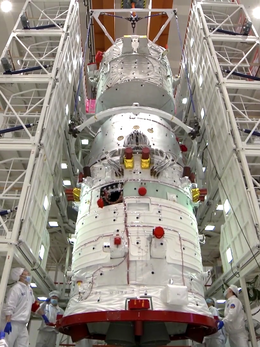 A Shenzhou spacecraft undergoing ground testing without solar panels | |
| Manufacturer | China Academy of Space Technology |
|---|---|
| Country of origin | |
| Operator | China Manned Space Agency |
| Applications | Crewed spaceflight |
| Specifications | |
| Launch mass | 8,100 kg (17,900 lb)[1] |
| Crew capacity | 3 |
| Dimensions | 9.25 m × 2.8 m (30.3 ft × 9.2 ft) |
| Volume | Total: 14.8 m3 (520 cu ft)[1] Habitable: 7 m3 (250 cu ft) |
| Regime | Low Earth |
| Design life | Up to 183 days (docked at the Tiangong space station) |
| Production | |
| Status | In service |
| On order | 0 |
| Built | 19 |
| Launched | 19 |
| Operational | 1 |
| Maiden launch |
|
Shenzhou (Chinese: 神舟; pinyin: Shénzhōu, /ˈʃɛnˈdʒoʊ/;[2] see § Etymology) is a Chinese spacecraft developed for the nation's crewed space program. Its design was based on Russia's Soyuz, but larger and modernized, Shenzhou is a single-use vehicle composed of three modules. The descent module houses the crew during launch and reentry. The orbital module provides additional living space and storage during orbit but is jettisoned before reentry. The service module, responsible for propulsion and power, is also discarded prior to reentry. For added safety and aerodynamics, the spacecraft is encased within a fairing with a launch escape system during liftoff.
Its maiden uncrewed flight, Shenzhou 1, was on 19 November 1999, with the first crewed mission, Shenzhou 5, taking flight on 15 October 2003. It is slated for replacement by the next-generation Mengzhou, currently in development, with a two module configuration similar to spacecraft like Apollo and Dragon.
- ^ a b 朱光辰 (2022). "我国载人航天器总体构型技术发展". 航天器工程. 第31卷 (第6期): 47.
- ^ "Shenzhou pronunciation". Dictionary.com. Retrieved 25 April 2015.